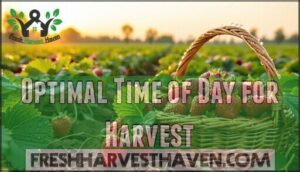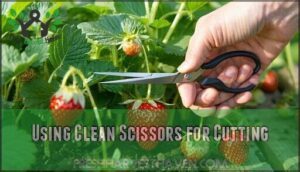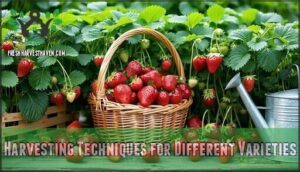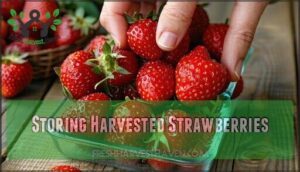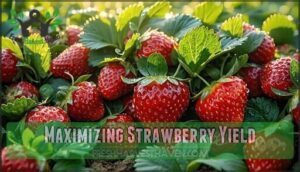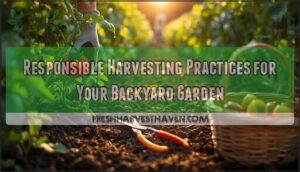This site is supported by our readers. We may earn a commission, at no cost to you, if you purchase through links.
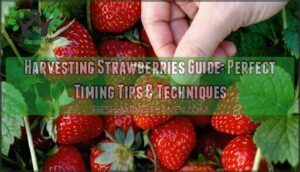
Gently pinch the stem about ¼ inch from the berry, leaving the green cap intact. Early morning works best when berries are cool and firm.
Skip any with white or green patches, as these taste sour and disappointing. Handle each berry like a precious gem to avoid bruising.
Clean hands or scissors prevent contamination that could spoil your harvest. The sweet spot between underripe and overripe lasts just a day or two, so timing your harvest perfectly requires knowing exactly what signs to watch for, and finding that perfect timing.
Table Of Contents
- Key Takeaways
- Harvesting Strawberry Basics
- Choosing Harvest Time
- Harvesting Strawberry Techniques
- Storing Harvested Strawberries
- Maximizing Strawberry Yield
- Frequently Asked Questions (FAQs)
- How do I know when to harvest my strawberries?
- What do coffee grounds do for strawberry plants?
- How to harvest strawberries?
- How long does a strawberry harvest last?
- When should you harvest strawberries?
- How can I improve my strawberry harvesting practices?
- How often should you pick strawberries?
- How do you pick a strawberry Berry?
- Do strawberries grow back after you pick them?
- How do you harvest strawberries?
- Conclusion
Key Takeaways
- Pick berries when they’re fully red and fragrant – You’ll get the best flavor when strawberries are completely red all around with no white or green patches, and they should smell sweet at the stem end.
- Harvest every 2-3 days during peak season – You can’t let ripe berries sit on the plant since they’ll become overripe quickly, so check your plants frequently during the main growing season.
- Use proper technique to avoid bruising – You should gently pinch the stem about ¼ inch from the berry or use clean scissors, handling each berry like it’s fragile to prevent damage.
- Time your harvest for early morning – You’ll get firmer berries with better sugar content when you pick them in the cool morning hours after the dew dries but before the heat of the day.
Harvesting Strawberry Basics
You’ll want to master the basics of strawberry harvesting to get the sweetest, most flavorful berries from your garden.
Understanding when your strawberries are perfectly ripe makes all the difference between a mediocre snack and a burst of summer sweetness.
Strawberry Ripening Patterns
Understanding strawberry ripening patterns helps you master the art of strawberry harvesting.
Different varieties follow unique ripening stages, from green to white to fully red.
Genetic factors and ripening hormones control this process, while environmental conditions like temperature and sunlight influence timing.
- Green to White Stage: Strawberries begin small and green, gradually enlarging and lightening
- Blush Development: Pink coloring appears first at the berry’s tip, spreading upward
- Full Color: Rich red develops completely, indicating peak strawberry ripeness
- Varietal Differences: Day-neutral varieties ripen continuously while June-bearing types have concentrated seasons
Environmental impact plays a key role in strawberry growth patterns.
Cool nights and warm days create ideal conditions for developing those perfectly ripe strawberries you’re after.
Factors Affecting Ripening Time
Several factors impact when your strawberries reach peak ripeness.
Sunlight exposure accelerates strawberry growth, while adequate soil nutrients fuel proper development.
Your watering practices directly affect crop ripening—consistent moisture helps berries develop their signature sweetness.
Temperature influence plays a major role too; warmer days speed up the process, cooler nights slow it down.
Different variety differences mean some strawberries ripen faster than others, affecting your harvesting timeline.
Strawberries also produce ethylene to trigger ripening, so proper monitoring is essential for peak ripeness and to understand how strawberries develop their signature sweetness.
Checking for Readiness
Your berries are ready when they display consistent color development across their surface. Perfect red strawberries won’t have white shoulders or green tips.
Apply the firmness test—ripe berries yield slightly to gentle pressure without being mushy.
Check these readiness indicators when picking strawberries:
- Color development: Deep red throughout, no white or green areas
- Firmness test: Slight give when pressed gently
- Seed prominence: Seeds sit flush with the surface, not sunken
- Aroma check: Sweet, fragrant smell at the stem end
- Calyx appearance: Green leaves separate easily from fruit.
The ripening process happens gradually, so daily harvesting tips include checking for these signs. When to harvest depends on these visual and tactile cues working together.
Choosing Harvest Time
Timing your strawberry harvest correctly makes the difference between bland, disappointing berries and sweet, juicy perfection.
You’ll want to pick your strawberries when they’re fully red and fragrant, typically every 2-3 days during peak season for the best flavor and texture.
Optimal Time of Day for Harvest
Start picking strawberries early morning after dew dries for maximum berry firmness and sugar content. Morning vs afternoon harvesting makes a significant difference—heat impact during midday reduces shelf life and quality.
Follow these harvesting tips during strawberry season for best results. Harvesting at the right time guarantees the best flavor, and peak ripeness matters for all produce.
| Time Period | Benefits | Drawbacks | Berry Quality | Best For |
|---|---|---|---|---|
| Early Morning (6-9 AM) | Cool temperatures, firm berries, peak sugar content | Wet from dew initially | Excellent firmness, maximum flavor | Fresh eating, storage |
| Mid-Morning (9-11 AM) | Dew dried, still cool, easy handling | Warming up slightly | Very good quality | All purposes |
| Midday (11 AM-2 PM) | No moisture issues | Heat stress, softer berries | Reduced firmness | Immediate use only |
| Late Afternoon (2-5 PM) | Cooler than midday | Still warm, declining quality | Fair to good | Quick processing |
| Evening (5-7 PM) | Temperatures dropping | Limited harvesting time | Good for next-day use | Preserving, jam-making |
When to harvest depends on your schedule, but morning picking delivers superior results every time.
Peak of Perfection – Taste and Texture
When your strawberry plants reach their peak ripeness, you’ll discover the perfect balance of ideal sweetness and ideal texture changes.
Fresh strawberries achieve maximum flavor development during their final ripening stages, transforming from firm to tender while maintaining berry firmness.
The best time to harvest occurs when natural sugars concentrate, creating that coveted sweet-tart flavor profile that makes harvesting strawberries worthwhile for any gardener, with the strawberries having reached the peak of their ripening stages.
Avoiding Overripe and Unripe Berries
You’ll know when to harvest strawberries by checking berry ripeness signs carefully.
Fresh strawberries should feel firm when gently squeezed – too soft means overripe, while hard berries lack sweetness.
Don’t judge by appearance alone; taste matters more than perfect looks.
Check your strawberry plants daily during peak season, as picking frequency affects quality.
Different varieties ripen at varying rates, so learn your specific plants’ patterns for ideal harvesting strawberries.
Harvesting Strawberry Techniques
Once you’ve determined your berries are ready, proper technique makes all the difference between bruised fruit and perfect strawberries.
You’ll want to use clean scissors or pinch the stem carefully to avoid damaging the delicate flesh that can turn mushy when handled roughly, which is why clean scissors are essential.
Using Clean Scissors for Cutting
Clean scissors are your best friend when harvesting garden strawberries.
Sharp, sterilized blades prevent disease transmission between plants while ensuring clean cuts that heal quickly.
Cut stems about half an inch above the berry, maintaining proper stem length for better storage.
Regular tool maintenance and scissors sterilization between rows protect your entire crop.
Proper sanitation requires effective sterilization methods.
This picking technique prevents bruising and extends shelf life substantially, using clean scissors and sharp blades for better storage.
Handling Berries to Prevent Damage
Once you’ve made your cuts, gentle handling becomes your best friend. Think of strawberries like delicate treasures that bruise easily.
Apply minimal picking pressure when transferring berries from plant to container selection. Your harvesting guide should emphasize avoiding bruising through careful movements.
- Cradle each berry like you’re holding a soap bubble – one squeeze too hard ruins everything
- Choose shallow containers so berries don’t get crushed under their own weight
- Skip washing timing until you’re ready to eat – wet berries spoil faster than dry ones
Garden strawberries reward patience with perfect flavor when you master these berry picking fundamentals.
Harvesting Techniques for Different Varieties
Different varieties demand specific picking techniques for maximum yield and quality.
June-bearing strawberries need concentrated harvesting every 2-3 days during their peak season, while day-neutral types require continuous attention throughout the growing season.
| Variety Type | Picking Frequency | Special Considerations |
|---|---|---|
| June-bearing | Every 2-3 days | Focus on peak 2-3 week window |
| Day-neutral | Every 2-3 days | Continuous harvest until frost |
| Alpine | Daily | Handle extremely delicate berries gently |
Everbearing varieties produce two main crops, requiring adjusted berry picking schedules.
Day-neutral strawberries offer steady production but smaller fruit size.
Alpine types need daily attention due to rapid ripening and delicate nature.
To prevent fruit bruising, use well-maintained tools to ensure the best results for your strawberry harvest.
This will help in maintaining the quality of the strawberries and ensure a good harvest yield.
Storing Harvested Strawberries
Once you’ve picked your perfect strawberries, proper storage becomes essential for maintaining their freshness and flavor.
You’ll want to handle these delicate berries with care since they bruise easily and can spoil quickly if not stored correctly, which makes proper storage and handling crucial for their longevity, and to preserve their natural sweetness and flavor.
Short-Term Storage Options
After picking your backyard strawberries, proper refrigeration methods extend their shelf life substantially.
Store unwashed berries in breathable containers with paper towels to control humidity. Don’t wash berries until you’re ready to eat them, as moisture accelerates spoilage.
To further enhance preservation, consider rapid cooling techniques immediately after harvest.
Organic strawberries from your garden stay fresh for 3-5 days when stored correctly in the refrigerator’s crisper drawer.
Long-Term Storage Methods – Freezing and Jamming
Everyone wants backyard strawberries to last beyond their brief season.
Freezing strawberries preserves nutrients for up to 12 months when stored at -18°C in airtight containers. For strawberry jam, you’ll need proper sugar content and pectin levels for setting.
Here are five key long-term storage methods:
- Blanch before freezing – Maintains better texture and color
- Use 60% sugar concentration – Essential for proper jam gel formation
- Sterilize jars properly – Prevents contamination and spoilage
- Vacuum seal frozen berries – Eliminates freezer burn completely
- Store jam in cool, dark places – Maintains quality for one year
Using the correct storage bags is essential for maintaining freshness. Both methods work perfectly for organic strawberries from your garden.
Preserving Strawberries for Later Use
Beyond freezing and jam-making, you’ll find plenty of ways to preserve your strawberry harvest.
Try drying techniques using a dehydrator or oven on low heat for chewy snacks.
Canning strawberries in light syrup extends their life substantially.
Create strawberry puree for smoothies, sauces, and baking.
These fruit preservation methods guarantee you’ll enjoy your strawberry cultivation efforts year-round.
Maximizing Strawberry Yield
You’ll get the best strawberry harvest when you focus on consistent care throughout the growing season.
Smart watering, proper fertilizing, and strategic pruning will boost your berry production while keeping plants healthy and productive for years to come, with consistent care being key to a successful harvest.
Watering and Fertilizing for Optimal Growth
Water your strawberries deeply once or twice weekly, providing one inch total.
Deep watering twice weekly beats shallow daily sprinkling for stronger strawberry roots.
Apply balanced fertilizer (10-10-10) monthly during growing season. Maintain soil pH between 6.0-6.5 for ideal nutrient uptake.
Watch for yellowing leaves indicating nitrogen deficiency or brown leaf edges suggesting potassium shortage. Consistent watering prevents blossom-end rot while proper fertilization boosts strawberry yield substantially, ensuring a healthy and productive strawberry yield.
Pruning and Training for Better Fruiting
Strategic pruning techniques transform your strawberry patch into a high-yield powerhouse.
Transform your strawberry garden into a berry-producing powerhouse with the right pruning approach.
Remove runners regularly to focus energy on fruit production rather than new plant development. Training methods like vertical growing maximize sunlight exposure while conserving space.
Proper runner management directs resources toward berry development. These strawberry care practices boost strawberry yield through focused strawberry cultivation guide principles that enhance overall strawberry plant care, utilizing strategic pruning techniques, vertical growing methods, and proper runner management.
Pest and Disease Management
During peak season, Common Strawberry Pests like spotted wing drosophila can devastate your crop.
Monitor regularly for early detection—it’s your best defense. Use Disease Prevention through proper spacing and drip irrigation.
Try Organic Solutions like neem oil first, then Chemical Treatments if needed. Rotate fungicide and insecticide classes to prevent resistance.
Effective control includes specialized pest products. Choose Resistant Varieties whenever possible for stronger strawberry care.
Frequently Asked Questions (FAQs)
How do I know when to harvest my strawberries?
You’ll know strawberries are ready when they’re fully red, shiny, and plump with a sweet fragrance. They should yield slightly to gentle pressure but remain firm, not mushy or overripe.
What do coffee grounds do for strawberry plants?
Coffee grounds provide nitrogen content, which will definitely benefit your berries and improve soil’s water retention.
They’ll also keep away sugar ants and pill bugs naturally, making them a smart addition to your strawberry patch.
For ideal growth, consider how coffee grounds affect soil pH to ensure optimal conditions.
How to harvest strawberries?
Pick strawberries every 2-3 days during peak season. Choose fully red, firm berries that fall off easily when gently twisted. Harvest in early morning for best flavor and quality.
How long does a strawberry harvest last?
Like a sweet symphony that plays for weeks, your strawberry harvest typically spans 4-8 weeks depending on variety and climate.
You’ll pick berries every 2-3 days during peak season for continuous bounty.
When should you harvest strawberries?
You’ll know it’s time when strawberries turn fully red, shiny, and plump with a sweet fragrance.
They should feel firm but not hard, and come off easily when gently twisted from the stem.
How can I improve my strawberry harvesting practices?
Like a treasure hunter finding perfect gems, harvest your strawberries every other day during peak season.
Pick in early morning when they’re fully red, firm, and fragrant.
Handle gently to avoid bruising.
How often should you pick strawberries?
You should pick strawberries every 2-3 days during peak season.
Daily checks help you catch berries at their prime ripeness, ensuring you don’t miss that perfect moment when they’re fully red and bursting with flavor.
This approach allows for timely harvesting and optimal enjoyment of the strawberries.
How do you pick a strawberry Berry?
Gently grasp the strawberry near the stem, then twist and pull upward with a slight rolling motion.
You’ll want to keep the green cap attached for freshness and longer storage life.
Do strawberries grow back after you pick them?
Yes, strawberries will continue producing new berries after you pick them. Each plant keeps flowering and setting fruit throughout the growing season, so you’ll harvest fresh berries every few days.
How do you harvest strawberries?
Wait for berries to turn fully red, then gently twist and pull them off with their green caps intact.
Harvest every 2-3 days during peak season, preferably in early morning when they’re coolest and firmest.
Conclusion
What happens when you’ve mastered the art of perfect timing in your strawberry patch?
You’ll transform from a novice gardener into a skilled berry harvester who knows exactly when those ruby gems reach their peak sweetness.
This harvesting strawberries guide has equipped you with the knowledge to identify ripe berries, choose prime harvest times, and employ proper techniques that preserve quality.
Remember, successful harvesting isn’t just about picking fruit—it’s about understanding your plants’ rhythm and responding accordingly.
With practice, you’ll develop an intuitive sense for perfect timing that guarantees every berry you harvest delivers maximum flavor and satisfaction.
- https://docs.google.com/forms/d/1GAQr3Kn1cURCVHUA82hAga1Wv8DCH0IuqDLRUrOpN7M/viewform?ts=63f4f653&entry.1515682415=https://www.merriam-webster.com/dictionary%2Fharvest
- https://premium.britannica.com/mw-unabridged/?utm_source=mw&utm_medium=inline-def&utm_campaign=evergreen
- https://www.freethesaurus.com/harvesting
- https://medical-dictionary.thefreedictionary.com/harvesting
- https://idioms.thefreedictionary.com/harvesting

